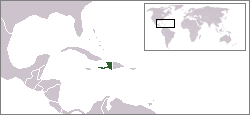| Revision as of 12:33, 10 November 2003 view sourceKarukera (talk | contribs)1,033 edits added piece of information← Previous edit | Revision as of 10:25, 13 November 2003 view source Vardion (talk | contribs)Autopatrolled, Extended confirmed users10,658 edits Adding location mapNext edit → | ||
| Line 10: | Line 10: | ||
| <i>From the ] 2000 and the U.S. Department of State website. Not Wikified.</i> | <i>From the ] 2000 and the U.S. Department of State website. Not Wikified.</i> | ||
| ] | |||
| * ] | * ] | ||
Revision as of 10:25, 13 November 2003
Haiti has been plagued by political violence and corrupt dictators for most of its history. Over three decades of dictatorship followed by military rule ended in 1990 when Jean-Bertrand Aristide was elected president. Most of his term was usurped by a military coup d'etat, but he was able to return to office in 1994 and oversee the installation of a close associate to the presidency in 1996.
About 80% of the population lives in abject poverty. Nearly 70% of all Haitians depend on the agriculture sector, which consists mainly of small-scale subsistence farming and employs about two-thirds of the economically active work force. The country has experienced little job creation since President Préval took office in February 1996, although the informal economy is growing. Failure to reach agreements with international sponsors have denied Haiti badly needed budget and development assistance. Meeting aid conditions in 2000 will be especially challenging in the face of mounting popular criticism of reforms.
From the CIA World Factbook 2000 and the U.S. Department of State website. Not Wikified.
- History of Haiti
- Geography of Haiti
- Demographics of Haiti
- Politics of Haiti
- Economy of Haiti
- Communications in Haiti
- Transportation in Haiti
- Military of Haiti
- Foreign relations of Haiti
See also: Haitian Creole, Music of Haiti
